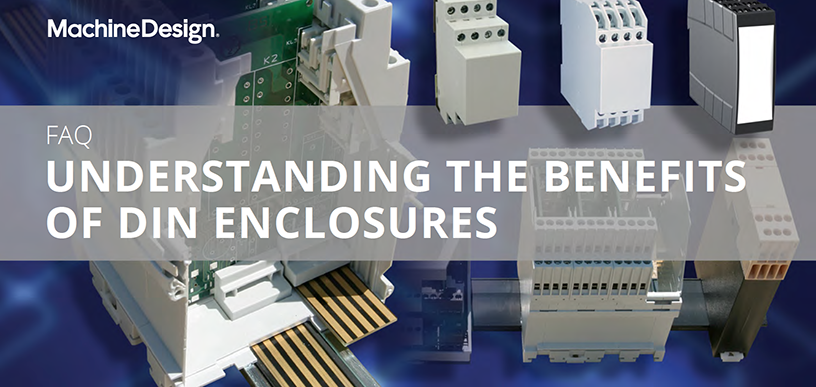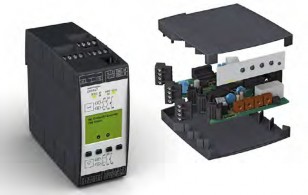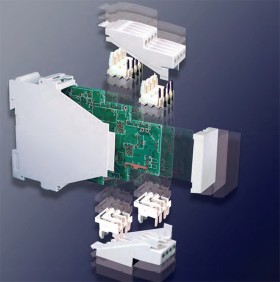
DIN enclosures are widely used in Europe and are growing in use in a broad variety of OEM systems across the world. These enclosures can be customized and fabricated to customer needs and specifications in OEM quantities.
What is DIN mounting and why should I consider using it?DIN is a metal rail standard widely used for mounting industrial control equipment inside of controls panels. They are broadly used in Europe for both industrial and home automation applications and should be considered whenever you are engineering a system for the global market.
Are DIN enclosures available in enough versions that I can use them in multiple applications?
Since DIN applications are limitless and work for all manner of electromechanical devices including relays, sensing and monitoring devices, timers, transducers, printed circuit boards, housing electrical and electronic systems, and much more, you can find a wide range of products. Can I incorporate a DIN enclosure without the high cost of specialized equipment?
Absolutely. Because DIN enclosures are widely used in Europe, they are readily available in a wide range of sizes and designs, choices of cover styles, terminal-to-board connection options, and 35mm DIN rail or panel mount configurations. For this reason, DIN enclosures are typically very economical, easy to assemble and install, and provide integral, ready-to- wire terminals in an attractive package. Because they are used globally, the level of quality meets or exceeds national and international standards for performance and safety.
What if I have a custom application?
Customization is fairly easy (see Exploded View). When working with the right supplier, they can cut special holes and cutouts for operating, setting, or indicating components that you wish to install, as well as include ventilation slots or special machined entrance points. Terminals can be marked for quick identification and efficiency in wiring as well. Even instructions and custom markings can be imprinted on the enclosures. Some enclosure manufacturers, such as Altech Corp. offer enclosures that can be molded in custom colors and custom configurations when ordered in OEM quantities. Further, some enclosures series offer a modular design that allows the user to incorporate different connection systems such as plug-in terminal blocks with screw or spring terminals (push-in). Series that include different switch cabinet enclosures, distribution enclosures, and a mounting rail bus system—for multifunction, compact, modular, or custom solutions are available.

Shown are two customization application examples.
What types of materials are the enclosures made from?
Depending on the series enclosure you need for your application, housing shell materials are generally glass-filled polyamide or glass-filled polycarbonate. Terminal materials include tinned bronze, brass, or steel with chromated steel screws, and spring terminals of stainless steel.
Do DIN enclosures come with extended environmental protections such as temperature and moisture? DIN enclosures are generally meant for use in panels so water protection is not necessary. The enclosures’ terminals are usually IP 20 rated to be touch proof and meet VBG4 as well as other European accident prevention requirements. Temperature ratings, depending on the enclosure series chosen can be up to 257 degrees F (125 degrees C) and meet UL94V-O standards.
Can I incorporate DIN components into my IoT system?
Since DIN enclosures and components are used around the world, they are perfect for IoT applications that need to have a standard look, feel, and interconnection. Equipment monitoring, building management and safety, home utilities, and other IoT applications can greatly benefit from using DIN enclosures for a clean, attractive, and consistent appearance.
I have a printed circuit board that I would like to convert to DIN rail. How do I incorporate a DIN enclosure into my design for holding the PCB and to make connections between the board and the outside of the enclosure?
DIN enclosures are made to incorporate specific sizes of printed circuit boards so that they are held securely in place. The PCB must be the correct size to mount properly in the enclosure. They are usually slid into PCB guides so your board may need to be modified to the correct size to fit properly. When choosing a DIN enclosure for an existing PCB you should look for a series that has a similar or larger PCB size as well as paying attention to the board layout and terminal configuration. Integrated terminals in the enclosure allow for different types of PCB connections like machine solderable pins, card edge connections and wire jumper or hand solder connections. These terminals are then terminated outside the enclosure with screw or spring clamp terminals for convenient wiring when the product is installed.

Seen in this exploded view, DIN enclosures incorporate a number of components, most of which can be customized to suit a wide variety of application needs. |

